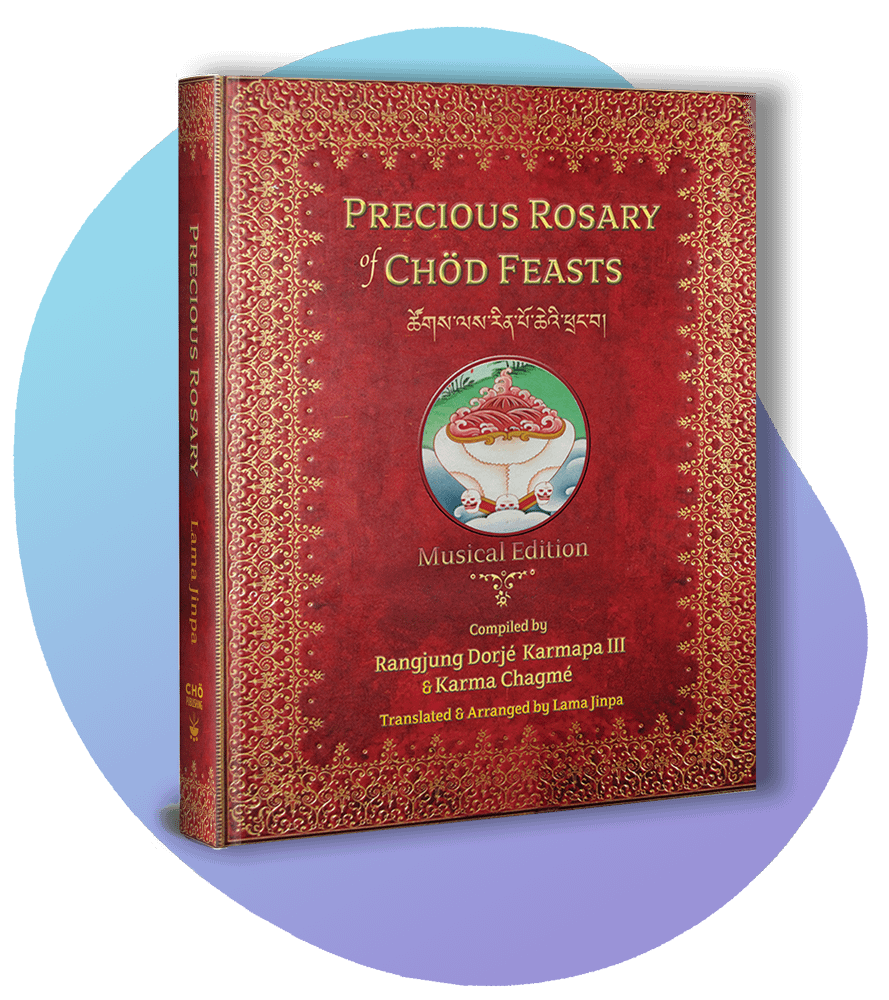Precious Rosary of Chöd Feasts

The Definitive Edition
Having the opportunity to study, practice and teach using the translated Precious Rosary over the course of a year, it became clear that I needed to create a revised edition. Its main purpose is to provide a solid basis for learning the otherwise complex melodies and phrasing in conjunction with easy-to-follow audio tapes. The music of Chöd is an essential component for “cutting through to freedom” and this particular melodic tradition of Chö fits the bill perfectly. A description of the meanings of all the notations and diacriticals can be found at the end of this text. Of course it also provided an opportunity to fix the inevitably orthographic, spelling and other mistakes, most of which are minor, but some are vital omissions or pronunciation (transliteration) fixes. While these will be available as an Errata document to users of the text, a completely corrected version is essential for now and into the future. I have also added the important MaChik Soldeb and the Lineage Prayer that precede the Precious Rosary in the Tibetan text. It is intended that future volumes will make available the six or seven traditional healing rituals of Chö, as well as the Dur or ritual for the departed to assist their bardo journey.
Crowning Jewel of Chöd
The Precious Rosary of Chöd Offerings has it all: feast, guru yoga, protector practice, dakini work, repairing of connection, karmic clearing, inner transformation, yidam practice, six yoga work and much more. This is the comprehensive collection of Chöd rituals and meditations directly from the tradition of MaChik herself. The legacy of the Precious Rosary consists of 21 additional texts, including six healing texts, a funerary or after death bardo guidance text and so on. Rangjung Rigpai Dorje, the Third Karmapa (c. 1300), collated these texts, correcting errors and ensuring that all extant writings were part of the MaChik's original Chöd tradition. Three hundred years later, Karma Chagmé (c. 1650), the famous Kagyu luminary, further polished the collection, preserving an accurate transmission to this very day.
The Chöd Legacy
The Tsokley Rinpoche Trengwa (or simply Rinchen Trengwa) is the main long Chöd ritual practiced by Kagyu and Nyingma lamas and yogis. Those practicing either the Machik or Nyingtik Chö, Drikung Chöd, or any of dozens of other terma traditions including the Dudjom Tersar, rely on the Precious Rosary as an extensive Tsok ritual. Others take it as their main practice, doing the full practice daily or focusing on different sections each day. Two such monasteries, strictly devoted to the Rinchen Trengwa, currently exist in Bhutan. The Precious Rosary is also ideal for group or solo retreats of 7, 14 or 30 days or longer. For all however, it is a comprehensive path, containing all the elements of both Chöd and Vajrayana.
The Text
The current Delhi version of the Tibetan text or "pecha" contains over 170 folios, while our current English transliteration and translation, combined with the Tibetan, fills over 300 letter size pages (8.5 x 11"). This is an accurate, poetic and practitioner-friendly translation of this important text, with the following features:
- A unique transliteration system that is easy to pronounce and read for non-Tibetan readers (the majority of students!), and dramatically different than the ponderous systems used elsewhere.
- Accurate translations of the meanings of the text, while attending to the lyrical and poetic nature of the original writings as much as possible.
- Full color text on the right side, with black and white Tibetan on the left, formatted for comparison and language study.
- Profuse color and black and white illustrations, portrayal of seed syllables, music notations, headings and subheadings, color-coding of the ten sections, oversize page numbering, etc.
- Durable hard cover, heavy duty bond paper with high quality inks.
- Each text is individually stamped and numbered.
- Includes chöpen (shrine activity) notations, symbols and directions.
Structure of the Precious Rosary
The Precious Rosary of Chöd Feasts can be naturally organized into 10 sections. A survey of these sections of the Tibetan text show the full range and depth of this remarkable work. Some of these "sections" were printing separately in old Tibet, indicating that the Third Karmapa (Rangjung Dorje) collected various pieces of MaChik's heritage, to create the seamless work now know as the Rinpoche Tsokley Trengwa (RTT). How we color-coded the 10 sections of the translation-practice text is shown below. Download the full Table of Contents at the top left of this page to see a more complete breakdown of the many sections of the RTT.

Click Below to download Sample Pages and the full Table of Contents..
Click the pic to download the flyer...

To Order the Precious Rosary
- Hardcover, 2nd Musical Edition.
- 300 pages, color illustrations
- Stamped, numbered and signed copies
- Book Price is $108.
- $75 upgrade for owners of 1st edition.
- Contact us for payment info

Preliminary Section
- Blessing the Offerings, Self-visualization, Summoning, Creating of the field of accumulation
- The Higher Guests; extensive Refuge, Bodhicitta and offerings.
Mantra Section
- Inner recitation, Purification
- Mantra for the sick
Feasts and Prayers Section
- Alternating praises and feasts, over a dozen different Red and White visualizations.
- include the Prayer to Padampa by MaChik, the songs of her son and doors of her reliquary, etc.
Ganachakra Section
- The Chod Ganapuja or Tsok, with the feasting of yogis and yoginis.
- inviting sacred guests of Lama, Dakini, Yidam and Protector.
Torma Section
- Tormas for Lama, Yidam
- Range of protectors
Kangwa Section
- Offerings to the various protectors of Chod for fulfilment of Samaya
- including those bound to service by MaChik and Padampa Sangye.
Dakini Offering Section
- Offering to the various classes of Dakinis
- Exhorting the 100,000 Dakinis, Dakinis of the 25 places and so on.
Protector Section
- Prayer and mantra recitation to the full range of some dozen Chod protectors
- 6-Arm Mahakala, Aghora, Palden Lhama, Cittipatti, Nagas, etc.
10. Concluding Section
- Chenrezig practice, Dedication, Confession, Sending back the Guests, etc.







